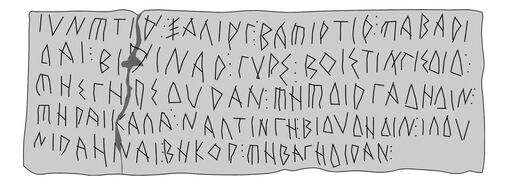THE IBERIAN CULTURE (THE IRON AGE)
 Iberian script
Iberian script
Between the 8th and 6th centuries BC a series of changes occurred in the late Bronze Age communities of our geographic area. The changes were caused to a great extent by the influences of Phoenicia (modern day Lebanon) and the southern Iberian peninsular. These gave way to the Iberian culture towards the end of the 6th and the beginning of the 5th century BC. The end of this phase was marked by the conquest and Romanisation of the Iberian peninsula beginning at the end of the 3rd century BC. From this time onward, the strong Roman influence disrupted and finally put an end to the most important features of the Iberian world.
The Iberian peoples were the creators of the first great civilisation on the Iberian peninsular, extending from Andalucía to the Languedoc. The Valencian region was one of the territories in which this culture's specific characteristics were most evident. Three populations occupied the present territory of Valencia, being - from south to north - the Contestanos, the Edetanos and the Ilercavones.
These territories were organised as small states with imprecise borders, having capital cities, towns and villages of varying importance. Many of these villages, with well planned urban centres, were surrounded by great walls and other defensive elements built of stone.
The Iberian economy was based on agricultural and livestock farming. The most important crops were wheat and barley, but there were additional crops such as the vine, olives, legumes and other cultivated or wild species.
This new culture contributed great innovations in all fields. The use of the potter’s wheel for ceramics became generalised. Vases often had painted decorations with a rich repertoire of geometric, plant and figurative motifs, domestic scenes of daily life, war scenes or motifs from the symbolic and religious world.
Also at this time iron metallurgy was introduced and spread, with farming tools, weapons, and every class of implement.
The Iberians were the first peninsular people to use their own alphabet to write their language, which is a pre-Indo-European language with some resemblance to the Basque tongue. Some investigators have succeeded in recognising symbols, but so far have not been able to decipher them.
The first Iberian coins appeared later in the 3rd century BC. This mintage in copper and silver appeared after coins had been already issued in Emporian (now Ampurias in Gerona), Gades (Cádiz) and Ebusus (Ibiza) and by the Carthaginians on the peninsula for some time. The principal mints of the Valencian Iberians were at Arse (Sagunto) and Saiti (Xátiva).
A specific characteristic of this culture is the funereal world, with crematory necropolises situated outside the towns. The Iberian ritual required the cremation of the body. The ashes were collected in a ceramic urn, which was then interred together with various pieces of grave goods (personal belongings used literally as a “funeral dowry”)
Little is known about Iberian religion. Temples have been found in some towns and in sanctuaries located in caves or on mountain summits, places where the devout left offerings. Also, many of the examples of Iberian art, such as sculpture, painting (on ceramics) and gold or silver work show us divinities and monsters from their complex world of beliefs

